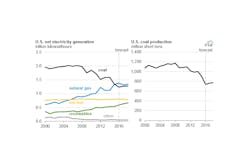Energy Update: U.S. coal production to rise in 2017 after 2016 fall
U.S. coal production & coal-fired electricity generation to rise in near term after 2016 decline
Coal production in the U.S. is at its lowest level since 1978, falling 18 percent from 2015 to 739 million short tons (MMst) in 2016, according to the U.S. Energy Information Administration (EIA). Coal production and coal-fired electricity generation are closely tied since nearly all coal produced in the U.S. used to generate electricity. With an expected price increase in gas prices in 2017 and 2018, coal is expected to recover some of the lost share of electricity generation mix. Likewise, coal production is expected to increase marginally.
U.S. coal production in 2016 totaled 743 MMst, 17 percent lower than in 2015, and the lowest level since 1978, according to the EIA. Falling production in 2016 continued an eight-year decline from peak production in 2008. Production in all major coal regions fell by at least 15 percent. Low natural gas prices, warmer-than-normal temperatures during the 2015-16 winter that reduced electricity demand, the retirements of some coal-fired generators, and lower international coal demand have contributed to declining U.S. coal production.
World’s nuclear plants have more than 390,000 MW generating capacity
A total of 449 operating nuclear reactors located in 31 countries around the world differ by age, types and number of reactors, and utilization, and offer a total installed generating capacity of more than 390,000 megawatts, according to the International Atomic Energy Agency. The largest nuclear plant in the U.S. is the Palo Verde plant near Phoenix, Arizona. It ranks ninth among the largest operating nuclear plants in the world with the highest capacity among the large plants, according to the EIA.
Coal Utilization Research Council expands mission and rebrand
Long-standing industry coalition the Coal Utilization Research Council adopted an expanded scope to add natural gas technology evaluation to its mission. The coalition rebranded under its new name, the Carbon Utilization Research Council (CURC), and will continue its commitment to advancing fossil energy technology solutions and increasing collaborative efforts to support fossil fuel technology development.
Established in 1998, CURC serves as an industry voice and advocate for technology pathways for the cost-effective use of coal resources in order to meet national energy needs while also achieving environmental and other societal goals. The coalition’s expanded focus will enable it to deliver technologies across the country.
Most new generating capacity additions are renewable technologies
Once final data are in, EIA expects 24 gigawatts of new generating capacity to be added to the power grid during 2016. For the third consecutive year, more than half of these additions are renewable technologies, especially wind and solar.
Of the 2016 renewable additions, nearly 60 percent were scheduled to come online during the fourth quarter. Renewable capacity additions are often highest in the final months of the year, in part, because of timing qualifications for federal, state, or local tax incentives. Estimated fourth-quarter capacity additions for 2016 are based on planned additions reported to EIA and are subject to change based on actual project schedules.
Power sector CO2 emissions fall below transportation sector emissions
Electric power sector carbon dioxide (CO2) emissions are now regularly below transportation sector emissions for the first time since the late 1970s, according to the EIA.
U.S. CO2 emissions from the transportation sector reached 1,893 million metric tons MMmt from October 2015 through September 2016, surpassing electric power sector CO2 emissions of 1,803 during the same time period. Emission level data through September 2016 are the latest available in EIA’s Monthly Energy Review.
Sulfur dioxide emissions from U.S. power plants have fallen faster than coal generation
Sulfur dioxide (SO2) emissions from the generation of electricity at power plants in the U.S. fell by 73 percent from 2006 to 2015, much faster than the 32 percent drop in coal-fired electricity generation during that same time, according to the EIA. Almost all electricity-related SO2 emissions are associated with coal-fired generation.
Indian Point set to retire by 2021
The two nuclear reactors at the Indian Point Energy Center in Buchanan, New York, will be retired following a last month agreement by Entergy Nuclear and the state of New York. Indian Point is one of four nuclear power plants in New York state and accounts for about 12 percent of total electricity generated from all sources statewide. It is located about 25 miles north of New York City. The agreement calls for Entergy to retire one reactor in April 2020 and the other in April 2021.
Ethane production in U.S. expected to grow
Ethane production in the U.S. is expected to increase from an average of 1.25 million barrels per day (b/d) in 2016 to 1.7 million b/d in 2018, according to the EIA’s latest Short-Term Energy Outlook. Petrochemical industry is expected to consume the increase in ethane production both domestically and abroad.


